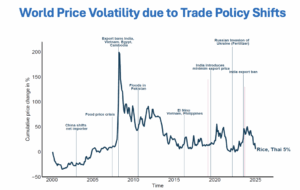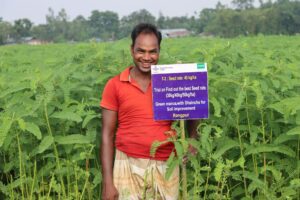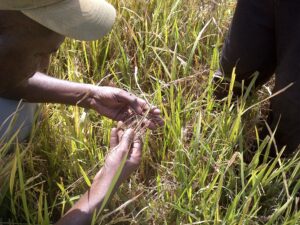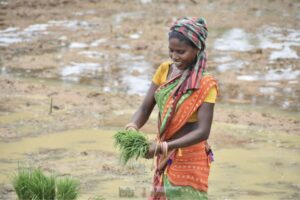With increasing human population and decreasing agricultural land area, there is worldwide pressure to increase food production in remaining agricultural land. Agricultural intensification, however, is associated with a number of environmental threats, including climate change, a degrading natural environment, and biodiversity loss. Thus, the challenge for global rice cultivation is to meet future food demands sustainably while reducing the environmental footprint.
One key strategy to meet future food production is to close “yield gaps.” A yield gap is defined by the Global Yield Gap Atlas as the difference between “potential yield” and “actual yield.” “Actual” yield is the mean yield achieved by farmers in a given region under dominant management practices while “potential yield” is the yield of the crop cultivar when grown with water and nutrients nonlimiting and biotic stress effectively controlled. Yield gaps can be measured using a variety of methods including crop growth simulation models, field experiments in which yield constraints are eliminated, and by the yield taken from the upper 10 percentile (“best farmers’ yield”).
The first two methods attempt to measure the maximum potential yield in a perfect growing environment with no constraints aside from climatic constraints, whereas “best farmers’ yield” is related to the best available and affordable technologies to the farmers at a given time.
Yield gap analysis is increasingly being used to identify the potential to increase food supply within a given area, as well as to understand important yield constraints. However, yield gaps should be interpreted with caution. To begin with, we need to understand the limitations and caveats associated with the various methods of analysis. We also need to take into consideration the environmental, economic, and social consequences of closing yield gaps.
For example, a study by Witt et al. (1999) published in Field Crops Research demonstrated that the most efficient use of nutrients would only produce rice yields at 70–80% of the maximum potential yield, after which the yield response to additional nutrient inputs diminishes. To gain the additional 20% in yield to close the gap, a disproportionate 70–90% increase in nutrient inputs are required—and that is in a perfect growing environment that rarely exists on a large scale. Such unsustainable use of resources to reach maximum potential yields would reduce profits as well as increase greenhouse gas emissions and pollution of waterways. This would be further exacerbated in cases where nutrient inputs are applied in excess of the plants uptake.
To address this issue, an “attainable (or exploitable) potential yield” set at 80% of maximum potential yield has been defined. This is certainly a step in the right direction towards identifying sustainable yield targets in underperforming areas. But there is still a need to identify whether the management practices applied to meet these targets are sustainable, especially in areas where attainable yields are already being achieved. For example, in China and Vietnam, overuse of fertilizers and other inputs in rice cultivation recently resulted in the introduction of national best management approaches (Three Controls Technology and One Must Do Five Reductions, respectively) that aim to reduce input use. These strategies led to reductions in fertilizer inputs and a simultaneous increase in yields through reduction in lodging and pest and disease outbreaks, realizing benefits for both the farmer and the environment.
To identify yield targets that are sustainable under current and future growing conditions, scientists from the Closing rice yield gaps in Asia with reduced environmental footprints (CORIGAP) project are working closely with rice farmers through household surveys, farmers’ diaries, and on-farm farmer participatory research. Differences in field characteristics, agronomic and postharvest practices, and socioeconomic issues between “best” yielding farmers and mean yielding farmers over time are being investigated to identify yield constraints, and whether yields achieved by the “best” farmers are indeed sustainable.
To conclude, we should only aim to close yield gaps in rice cultivation to levels that are sustainable, using best management practices such as optimizing nutrient and water use and minimizing other inputs that harm the environment and human health. This is expected to be most profitable to the farmer as well as address issues relating to food security and environmental health.










